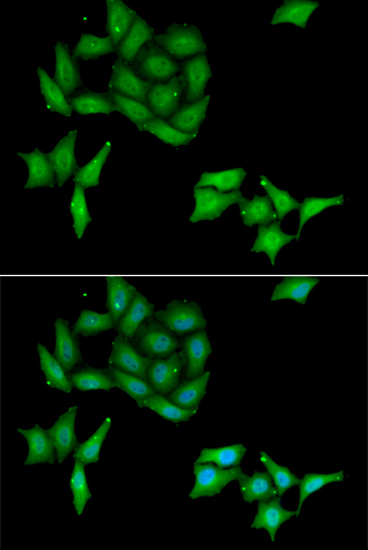-
Product Name
CCNC Polyclonal Antibody
- Documents
-
Description
Polyclonal antibody to CCNC
-
Tested applications
WB, IF
-
Species reactivity
Human, Mouse, Rat
-
Alternative names
CCNC antibody; CycC antibody; SRB11 antibody; hSRB11 antibody; cyclin-C antibody
-
Isotype
Rabbit IgG
-
Preparation
Antigen: Recombinant fusion protein containing a sequence corresponding to amino acids 1-283 of human CCNC (NP_005181.2).
-
Clonality
Polyclonal
-
Formulation
PBS with 0.02% sodium azide, 50% glycerol, pH7.3.
-
Storage instructions
Store at -20℃. Avoid freeze / thaw cycles.
-
Applications
WB 1:500 - 1:2000
IF 1:50 - 1:200 -
Validations

Western blot - CCNC Polyclonal Antibody
Western blot analysis of extracts of various cell lines, using CCNC antibody at 1:1000 dilution.Secondary antibody: HRP Goat Anti-Rabbit IgG (H+L) at 1:10000 dilution.Lysates/proteins: 25ug per lane.Blocking buffer: 3% nonfat dry milk in TBST.Detection: ECL Basic Kit .Exposure time: 60s.

Immunofluorescence - CCNC Polyclonal Antibody
Immunofluorescence analysis of HeLa cells using CCNC antibody . Blue: DAPI for nuclear staining.
-
Background
Component of the Mediator complex, a coactivator involved in regulated gene transcription of nearly all RNA polymerase II-dependent genes. Mediator functions as a bridge to convey information from gene-specific regulatory proteins to the basal RNA polymerase II transcription machinery. Mediator is recruited to promoters by direct interactions with regulatory proteins and serves as a scaffold for the assembly of a functional preinitiation complex with RNA polymerase II and the general transcription factors. Binds to and activates cyclin-dependent kinase CDK8 that phosphorylates the CTD (C-terminal domain) of the large subunit of RNA polymerase II (RNAp II), which may inhibit the formation of a transcription initiation complex.
Related Products / Services
Please note: All products are "FOR RESEARCH USE ONLY AND ARE NOT INTENDED FOR DIAGNOSTIC OR THERAPEUTIC USE"
